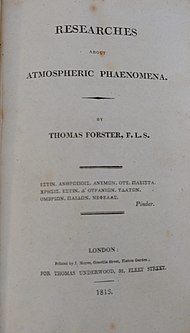Thomas Ignatius Maria Forster
Thomas Ignatius Maria Forster FLS | |
|---|---|
 Etching of Thomas Forster with his dog Shargs | |
| Born | 9 November 1789 London, England |
| Died | 2 February 1860 (aged 70) Brussels, Belgium |
| Alma mater | Corpus Christi College, Cambridge |
| Occupation(s) | Astronomer, physician, naturalist, philosopher |
| Spouse |
Julia Beaufoy (m. 1817) |
| Children | 1 |
| Parent |
|
| Relatives |
|
Thomas Ignatius Maria Forster
Life
Forster was born in
After his return to England he became a fellow of the Royal Astronomical Society and helped to found a meteorological society along with Sir Richard Phillips, which had only a brief existence.[1]
After his father's death in 1825, he took up his residence in
Forster lived in Bruges, Belgium, from 1842 until 1852. He then moved to Brussels, where he died on 2 February 1860.
Works
In 1805 Forster had compiled a "Journal of the Weather" and had published his Liber Rerum Naturalium. In 1806, inspired by Gall's works, he took up the study of phrenology.[1] Later he met Johann Spurzheim, and studied with him the anatomy and physiology of the brain. Forster accompanied Spurzheim to Edinburgh, where he communicated a paper on the comparative anatomy of the brain to the Wernerian Society. On his return to London he published a sketch of Gall and Spurzheim's system, which, like many of his writings, appeared in the Pamphleteer, together with an essay on the application of the organology of the brain to education.[2] He coined the term "Phrenology" in 1815.[6] Forster was influenced by John Abernethy under whom he studied surgery. Abernethy believed in diet as being key to health and Forster in his 1813 In 1813, Forster published his Physiological Reflections on the Destructive Operation of Spiritous and Fermented Liquors on the Animal System where he traced his vegetarianism to Italian renaissance writing, Pythagorean ideas on the transmigration of the soul, cruelty to animals, and Hindu practices. He also influenced Shelley's conversion to vegetarianism.[7]

His observations and studies in Continental Europe led to the publication, in 1824, of his "Perennial Calendar". In 1830 he collected and published the letters of
Other publications included:
- Researches About Atmospheric Phaenomena (London, 1813; 2nd ed., 1815)
- Reflections on the Destructive Operation of Spirituous Liquors (London, 1812)
- Somatopsychonoologia (1823) written under the pen-name Philostratus
- Pocket Encyclopedia of Natural Phenomena (from his father's MSS., 1826)
- Medicina Simplex (1832)
- Beobachtungen uber den Einfluss des Luftdruckes auf das Gehor (Frankfurt, 1835)
- Observations sur l'influence des Cometes (1836)
- Philozoia, or Moral Reflections on the actual condition of the Animal Kingdom, and the means of improving the same (Brussels, 1839)
- Pan, a Pastoral (Brussels, 1840)
- Essay on Abnormal Affections of the Organs of Sense (Tunbridge Wells, 1841)
- Sati or Universal Immortality (1843) [in which he wrote favourably on sati, considering it consistent with Christianity]
- Annales d'un Physicien Voyageur (Bruges, 1848)
- Numerous articles in The Gentleman's Magazine
- A Synoptical Catalogue of British Birds: Intended to Identify the Species Mentioned by Different Names in Several Catalogues Already Extant. Forming a Book of Reference to Observations on British Ornithology (printed by and for Nichols, son, and Bentley, 1817)
-
1813 copy of Forster's "Researches about atmospheric phaenomena"
-
Table of contents for "Researches about atmospheric phaenomena"
-
First page of "Researches about atmospheric phaenomena"
References
- ^ a b c d e f Herbermann, Charles, ed. (1913). . Catholic Encyclopedia. New York: Robert Appleton Company.
- ^ a b . Dictionary of National Biography. London: Smith, Elder & Co. 1885–1900.
- ^ "Forster, Thomas [Ignatius Maria] (FRSR812TM)". A Cambridge Alumni Database. University of Cambridge.
- PMID 13381149.
- ^ Tristram Stuart, The Bloodless Revolution, W. W. Norton & Company, 2006, pp. 374-375.
- .
- JSTOR 30213109.
- Attribution
 This article incorporates text from a publication now in the public domain: Herbermann, Charles, ed. (1913). "Thomas Ignatius Maria Forster". Catholic Encyclopedia. New York: Robert Appleton Company. Cites:
This article incorporates text from a publication now in the public domain: Herbermann, Charles, ed. (1913). "Thomas Ignatius Maria Forster". Catholic Encyclopedia. New York: Robert Appleton Company. Cites:
- Forster, Recueil de ma Vie (Frankfurt, 1835)
- Epistolarium Forsterianum (Bruges, 1845–50)
- . Dictionary of National Biography. London: Smith, Elder & Co. 1885–1900.
- Joseph Gillow, Bibl. Dict. Eng. Cath.



